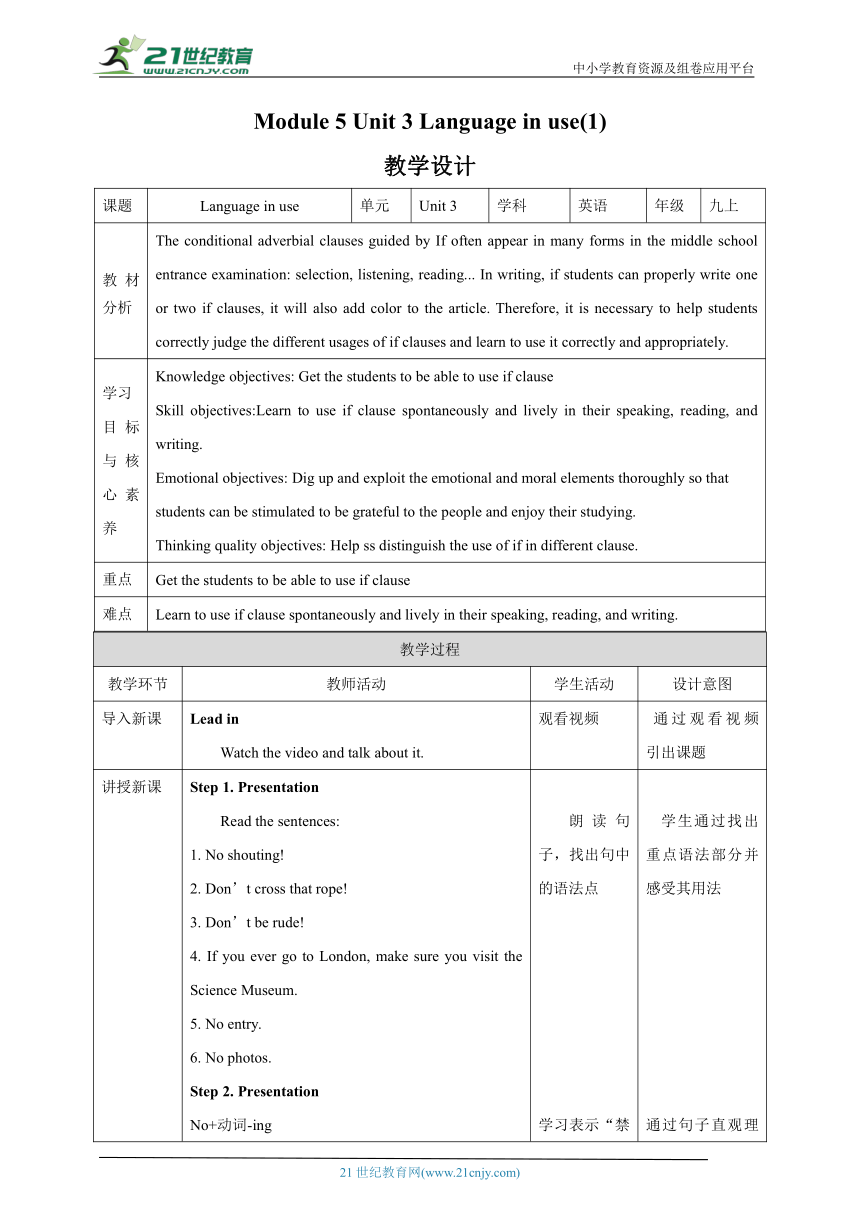
中小学教育资源及组卷应用平台 Module 5 Unit 3 Language in use(1) 教学设计 课题 Language in use 单元 Unit 3 学科 英语 年级 九上 教材分析 The conditional adverbial clauses guided by If often appear in many forms in the middle school entrance examination: selection, listening, reading... In writing, if students can properly write one or two if clauses, it will also add color to the article. Therefore, it is necessary to help students correctly judge the different usages of if clauses and learn to use it correctly and appropriately. 学习目标与核心素养 Knowledge objectives: Get the students to be able to use if clauseSkill objectives:Learn to use if clause spontaneously and lively in their speaking, reading, and writing.Emotional objectives: Dig up and exploit the emotional and moral elements thoroughly so that students can be stimulated to be grateful to the people and enjoy their studying.Thinking quality objectives: Help ss distinguish the use of if in different clause. 重点 Get the students to be able to use if clause 难点 Learn to use if clause spontaneously and lively in their speaking, reading, and writing. 教学过程 教学环节 教师活动 学生活动 设计意图 导入新课 Lead inWatch the video and talk about it. 观看视频 通过观看视频引出课题 讲授新课 Step 1. PresentationRead the sentences:1. No shouting!2. Don’t cross that rope!3. Don’t be rude!4. If you ever go to London, make sure you visit the Science Museum.5. No entry.6. No photos.Step 2. PresentationNo+动词-ing No shouting, please! 请勿喧哗! No smoking. 禁止吸烟。 No + 动名词表示“禁止做某事” e.g. No joking! 不要开玩笑! No + 名词 No + 名词表示“禁止做某事” e.g. No photos. 请勿拍照。 No entry. 请勿入内。祈使句 祈使句用来表达叮嘱、劝告、希望、禁止、警告、请求或命令等。祈使句最常用来表达命令。Go and wash your hands. 快去洗手。 (命令)Be quiet, please. 请安静。 (请求) Be kind to our sister. 要对我们的妹妹友善。 (劝告) Watch your steps. 走路小心。 (警告) No littering. 不要乱扔垃圾。 (禁止) Don’t forget to take an umbrella. 不要忘了带雨伞。 (叮嘱)祈使句的特点 (1) 祈使句一般没有主语,说话的对象都是第二人称“你”或“你们”,所以也可以理解为省略了主语you。祈使句末用句号或惊叹号,句子读时用降调。 (2) 以动词原形开头,无时态和数的变化。 (3) 祈使句的否定形式是在动词原形前加don’t。(4) 在表达请求时,可以加上please; 表达比较强烈的语气时,可以用感叹号。 Please close the door. Sit down, e to my office. 到我办公室来。 Stop! 停! Hurry up! 快点! Please don’t do it. 请不要这么做。 Don’t be late again. 不要再迟到了。(5) Let’s 构成的祈使句往往用于提出建议。否定形式为:Let + 宾语 + not + 动词原形 + 其它成分。如: Let’s go to school together. Let him not go. (6) 在请求、命令和口号中,常用无动词祈使句,它实际上是省略了动词,从而使句子更简洁有力。如: Just a minute, please! 下面的口诀总结了祈使句的一般规律。一起来看看吧! 祈使句, 有特点, 动词原形摆在前, 否定句式也不难, Don't 放在最前面, 其它一律都不变。 状语从句if引导的状语从句。if引导的状语从句不是指已经发生的事件,而是指能够发生或可能发生的事件。if从句+ ... ...
~~ 您好,已阅读到文档的结尾了 ~~

